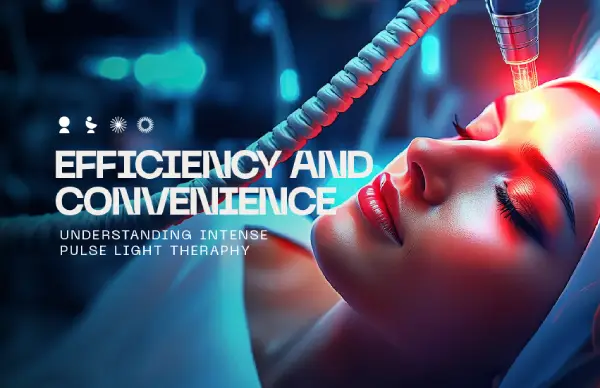Blog
Is IPL a Quick Fix for Acne?

Contents
What is IPL?
How IPL therapy works
Using IPL to treat acne
Is IPL therapy for everyone?
Are there side effects to IPL?
Preparing for IPL acne treatment and aftercare
Comprehensive steps to managing acne
IPL: Your path to acne-free skin
Do you know that IPL therapy offers effective results for acne?
This non-surgical treatment is a safe alternative to traditional treatments. Many people perceive it as a fast solution because it takes about 30 minutes to complete. Is IPL a quick fix, though?
Continue reading to understand IPL therapy and how it treats acne. Discover if there are limitations and find out if you’re a suitable candidate for the procedure. Learn how to prepare for the treatment and what to expect.
What is IPL?
Intense pulsed light (IPL) is an FDA-approved phototherapy for various skin conditions. The procedure treats acne, birthmarks, wrinkles, scars, and spots. It also repairs sun exposure (photoaging) damage.
While laser treatments apply single-pulse energy, IPL uses multiple pulse wavelengths. This technique allows it to cover a larger skin area than the former.
This non-surgical procedure is nearly painless and has a short recovery time. People refer to IPL therapy as a “lunchtime” treatment, as a session takes 15–30 minutes. You can undergo the therapy during your break and return to work afterward.
Many patients prefer IPL therapy, as traditional skin treatments have more adverse side effects. You may experience a minor reaction, but it’s temporary. Follow your practitioner’s instructions to minimize discomfort.
Expect to see some changes, but it takes multiple sessions to achieve optimal results. You’ll continue to see improvements in your skin texture, tone, and appearance over the next few months.
The exact number of treatments depends on the severity of the problem and how you respond. Sessions are usually three to four weeks apart to let your skin heal. Consult a specialist to determine the best action plan.
How IPL therapy works
An IPL practitioner uses a handheld device to deliver multiple light wavelengths onto your skin. The heat breaks down damaged skin cells before your body removes the unwanted tissue naturally.
At LIVV Natural, we use Lumecca for our IPL treatments. It’s the most powerful form of intense pulsed light. The device emits a bright light flash during the session. Patients observe significant improvements in their skin complexion after one treatment.
Using IPL to treat acne
Acne results from excess sebum, bacteria, clogged pores, and inflammation. Conventional treatments include oral and topical antibiotics, retinoids, benzoyl peroxide, and isotretinoin. These drugs may cause adverse side effects.
Many people prefer IPL therapy to conventional treatments because there are fewer side effects. According to research, IPL treatments are effective, offer minimal discomfort, and produce excellent results.
Below are the main differences between IPL and traditional acne treatments.
- IPL is more convenient and offers faster results. A therapy session takes about 15–30 minutes every 3–4 weeks. Most patients see results after a few treatments. Acne medication may take weeks or months to show improvement.
- IPL treats more skin conditions than acne. It also reduces signs of acne scars, photoaging, redness, pigmentation, and wrinkles.
- IPL has no adverse side effects compared to drug treatments. You may experience minor pain, redness, peeling, or swelling that goes away within a few days. Traditional medication may cause allergic reactions, dryness, irritation, nausea, or headaches.
Let’s take a look at how IPL treats acne.
Eliminates bacteria
The Propionibacterium acnes (P. acnes) pathogen protects the skin by preventing bacteria from getting into the pores. The downside is that it also causes acne. The light from IPL treatments triggers a reaction that eradicates the bacteria.
Promotes healing without scarring
Studies show that IPL synthesizes collagen and elastic fiber in the skin. Evidence confirms that this action reduces scar formation as acne lesions heal.
Reduces inflammation
Inflammation can lead to acne. Eliminating the cause minimizes the risk of the condition. Acne also causes red and pink blotches called post-inflammatory erythema (PIE).
Popping pimples may activate more inflammation. Post-inflammatory hyperpigmentation (PIH) marks also appear when skin trauma leads to excess melanin buildup. Research shows that IPL totally or partly removes PIE and PIH.
Regulates sebum production
The body secretes sebum to moisturize and protect the skin, but excess oil clogs the pores. This condition increases the risk of acne formation.
Light from IPL devices damages the capillaries that feed the sebaceous glands. It decreases their size and function, reducing oily skin.
Is IPL therapy for everyone?
Generally, IPL therapy is most suitable for people with a light complexion and dark hair. The light can easily differentiate between the treatment spot and the surrounding skin.
Patients with red hair or very fair skin may not experience noticeable outcomes. The lack of tone contrast makes it difficult for the light to locate the treatment spot.
People with skin cancer, infections, or keloid scars shouldn’t undergo IPL treatment. Those with psoriasis, dermatitis, or eczema must defer therapy until the symptoms subside.
Take precautions before and after IPL sessions if you have sensitive skin. Avoid sun exposure, tanning, perfumes, retinoids, makeup, and alcohol.
Consulting a medical professional is the best way to determine if IPL therapy suits your needs. The doctor will also provide pre and post-session instructions.
Are there side effects to IPL?
Although IPL therapy doesn’t have severe side effects, you may experience the following reactions.
- Mild to moderate pain or discomfort during or after the procedure.
- Sore, pink, or red skin for a few days after the treatment.
- A mild sunburn sensation, including peeling and swelling.
- Discoloration and texture changes, especially for darker-skinned people.
These side effects are minor and temporary and usually disappear after a few days. You can minimize the discomfort by following your practitioner’s instructions. Contact your doctor immediately if you experience severe symptoms.
Preparing for IPL acne treatment and aftercare
Consult a medical professional if you’re planning to undergo IPL therapy. The doctor will examine you, review your medical history, and explain the procedure. Inform the specialist of your expectations to ensure they’re realistic.
Let the doctor know about the medications or supplements you’re taking. Some may increase skin sensitivity or have a bleeding risk. You may have to stop taking them before the therapy session.
Pre-treatment
Here are some of the precautions to consider before an IPL procedure.
- Avoid sunbathing and tanning beds. Use sunscreen and protective clothing to minimize sun exposure outdoors.
- Don’t do chemical peels, waxing, or collagen injections before a session.
- Abstain from smoking, as it can hinder healing and accelerate aging.
- Avoid retinoids, alpha-hydroxy acids, beta-hydroxy acids, benzoyl peroxide, and alcohol, as they may increase sensitivity.
- Stop using aspirin, anti-inflammatory drugs, or herbal supplements. These drugs can contribute to the risk of bleeding.
Take these precautions at least two weeks before your treatment. Also, avoid using deodorant or perfume on the affected area.
Shave the spot a day before the session to ensure optimal light penetration. Remove makeup and other cosmetics from the area. Be sure to stay hydrated and apply a gentle moisturizer to keep your skin soft and healthy.
Post-treatment
Avoid using makeup or applying lotion to the treated spot for a day. The area may be reddish or pinkish after the procedure. This condition typically lasts a few hours, sometimes longer. Wait for all signs to dissipate before applying chemicals on the spot.
You may experience mild pain or notice redness or swelling. Your skin might peel. Apply ice packs, soothing creams, or cool washcloths to relieve any symptoms.
Comprehensive steps to managing acne
Managing acne requires a comprehensive approach to treat the condition and minimize complications. It’s critical to consult a medical professional.
A medical practitioner will advise you on the steps to take and recommend a treatment. The doctor will assess the problem and address the underlying causes. Considering contributing factors, such as genetics, lifestyle, and diet, is essential.
Monitoring your response to the procedure and assessing your progress is vital. The practitioner will adjust your treatment program if necessary.
IPL: Your path to acne-free skin
There are many reasons to choose IPL therapy to treat acne. You don’t need to take medication or undergo surgery. The procedure uses light therapy to penetrate the skin.
The session length depends on the treatment area and severity. A typical procedure takes about 30 minutes.
IPL therapy has no recovery period. You may undergo a session during your lunch break and return to work afterward. There are minimal side effects compared to traditional acne treatments. Improvements are noticeable after a few sessions.
Always consult with an experienced IPL practitioner. Following the specialist’s advice ensures a procedure without complications.
Are you ready to begin your journey to acne-free skin? Arrange a consultation with our LIVV Natural professionals today.
Author: Dr. Jason Phan NMD – Founder of LIVV Natural – Anti-aging – regenerative medicine – peptide therapy


